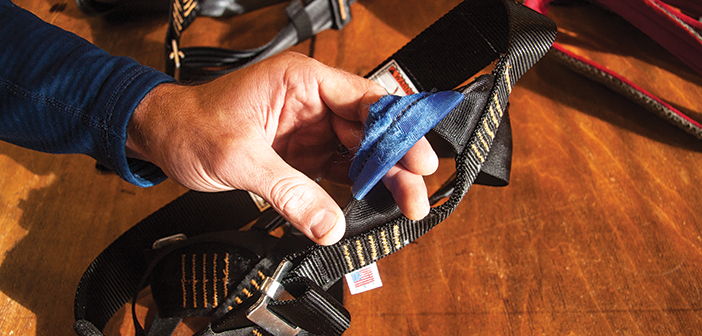Harnesses are essential equipment for adventure park operators, and a key piece of the overall experience. They must be comfortable, of course, but also maintained properly so that they function as designed. Since adventure park operators mainly serve a populace that isn’t expected to know about harness use, not to mention able to recognize signs of wear or other red flags, that responsibility falls on operators and staff. Proper care is not just a matter of compulsive cleaning or regularly buying new harnesses; there are dos and don’ts with regard to care that can ensure harnesses function properly, enjoy a long life, and are cost effective.
Harnesses, typically made from very finely spun nylon, are built to withstand the impact of a fall and distribute that impact safely throughout the user’s body. So harness care begins with careful inspection. A rigorously attentive eye keeps them functioning well and outside the realm of any unnecessary mishaps.
“I tell people to always assume something is wrong. If you start with the opposite assumption, you are not looking for issues, and if you are not looking for issues, you will never find them,” says Carson Rivers, VP of operations for Challenge Towers Aerial Adventures and High Gravity Adventures.
Here are some of the main points of harness care to focus on.
INSPECTION
At the cornerstone of harness care is daily, thorough inspection, says Phil Hoffman, sales manager for Misty Mountain, which has manufactured and sold climbing harnesses since 1985.
“We recommend inspecting the harness every time before the operator puts it on a participant, and making sure inspection is on a pre-operations checklist,” Hoffman says. “It’s also advised to keep a logbook of when the harness was purchased, how often the harness is used, and if the harness was involved in any falls or rescues.” All that can help determine when a harness is due for replacement.
At the courses that Rivers manages, each harness is checked multiple times during the day. He trains employees to check harnesses as they leave the gear room; again after guests finish ground school; then once more at the course entrance, where every guest passes through to start their trip on the course; and finally, when guests return their gear, the staff does a final inspection before harnesses are returned to the rack in the gear room.
Since many parks and zip tours are seasonal, they often bring in professional inspectors to assess the operation’s equipment and determine what equipment remains suitable for use, what needs to be retired, and to uncover any issues or questions that should be addressed to the manufacturer. Craig Stevens, general manager for harness manufacturer Robertson Harness, stresses the importance of regular inspections to complement that professional inspection. He, too, recommends operators have a system to log observations, and include all pertinent information to each specific piece of gear.
And what to check? Two key points of visual inspection are the bar tack and the webbing, to identify fraying or other signs of damage. The same applies to the harness tethers.
The harness should also be physically held to test for stiffness, as this can also be a warning sign. Stiffness often comes from overexposure to UV light, which can contribute to nylon degradation.
Jeremiah Wangsgard, technical information manager for Petzl, the company Rivers cites as his reference for maintenance, emphasizes the importance of the inspection being performed by a competent, trained individual. “Because the responsibility of inspection falls on the operator, it is important that the operator is properly trained and competent in performing equipment inspection,” he says.
To make that a reality, he adds, “Petzl offers a PPE (personal protective equipment) Inspection Competent Person course, which includes an assessment and certificate for those who successfully complete the course.”
Another inspection item: buckles. Check these for signs of corrosion, abrasions, or sharp edges. This is especially important in coastal areas where a higher level of environmental impacts can affect harnesses. Petzl advises users to “check the condition of the adjustment buckles for marks, cracks, wear, deformation, and corrosion. Check that the straps are correctly threaded, with no twists, and verify that the buckles operate properly,” according to a safety document issued by the company.



